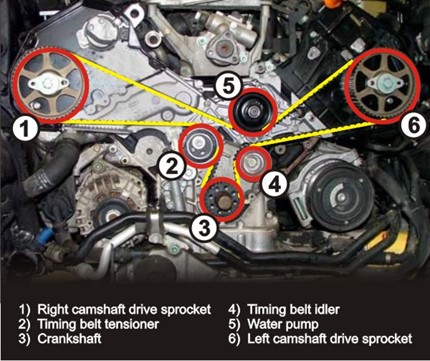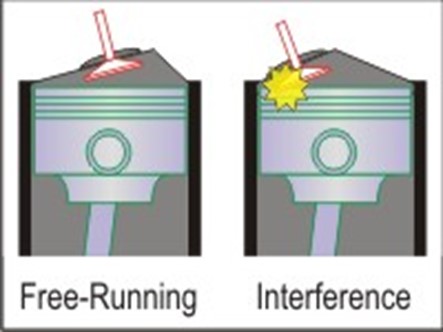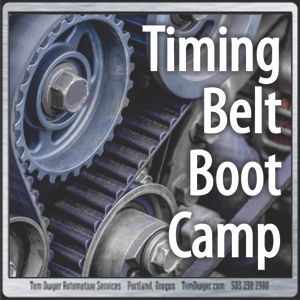Timing Belt Boot Camp
If your timing belt fails your car dies. Best to understand it.
(updated from Jan 2011)
Many of your vehicle’s components are easily accessible and show wear. When one of these is about to break we can tell, so we can fix it (if it’s already failed) or fix it proactively (if it’s about to fail). Other components are buried so deeply in the engine there’s no way to check them without disassembling the major parts of the vehicle. These have to be replaced by time or mileage intervals, and one of the most important of these components is your Timing Belt. If we don’t have a record of a timing belt replacement and your vehicle is near the recommended interval, we’ll definitely want to talk with you about it.
The only thing worse than one of our Service Advisors telling you your timing belt needs replacement is when they have to tell you the old belt failed and damaged your engine. Preventative replacement (especially done the right way) is expensive, but letting this critical belt fail adds even more expense and inconvenience. Tom calls it one of our most disappointing repairs, because clients spend a lot of money for the service but if it’s done right then it you won’t notice any improvement at all. You won’t have the feeling of satisfaction that new tires, clean fuel injectors, or even a new windshield will provide. There’s really not much to feel good about other than a sense of security. So why bother? What’s a timing belt, why is it so important, and what does it take to do the job right?
What’s a timing belt?
When it’s running, your engine is an amazing ballet of delicate parts moving past each other at thousands of revolutions per minute. A timing belt synchronizes the motion of the engine’s crankshaft, camshaft, and other parts so they move in precise coordination (timing). The belt is hidden beneath a cover (or covers) underneath all the other belt-driven appliances on the front of the engine. Because they’re so inaccessible and there are no reliable visible indicators of wear, timing belts must be changed on a manufacturer-recommended mileage or time interval (typically about 90,000- 120,000 miles or 10-15 years).
The timing belt is one of your most critical and potentially fragile engine components. Older engines use a metal chain lubricated by motor oil to accomplish this amazing synchronization. The industry moved toward the external fiber timing belts in the 70’s and 80’s and they became predominant before 2000. Manufacturers have been shifting back in recent years and now more vehicles have chains instead of belts. There are pros and cons to each, but fiber belts are like rubber bands that get brittle over time and chains rust and wear. We lean toward the chains because they’re just a little sturdier and have a slightly longer life.
Your timing belt is NOT your serpentine belt. Both belts connect and coordinate multiple components, but the serpentine belt is more exposed making it easier (and cheaper) to work on and to evaluate its condition. Both belts are vital to your vehicle and both can leave you stranded if they fail, but the timing belt is much more likely to do engine-ending damage if it goes bad.
Let’s dive into your engine
 This is what an engine looks like with the front cover removed, and you can see the torturous path the belt (yellow) takes through all the critical components (red) it connects. This picture shows an engine with just a single timing belt, but some engines have multiple timing belts and multiple camshafts. No matter the engine, the story is the same: if the timing belt fails your engine either won’t start or will stop running.
This is what an engine looks like with the front cover removed, and you can see the torturous path the belt (yellow) takes through all the critical components (red) it connects. This picture shows an engine with just a single timing belt, but some engines have multiple timing belts and multiple camshafts. No matter the engine, the story is the same: if the timing belt fails your engine either won’t start or will stop running.
 For engines with sufficient valve clearance (“free running engines”), when the timing chain (or belt) breaks the vehicle may coast gracefully to the side of the road incurring inconvenience, a tow bill, and an unscheduled timing belt replacement. “Interference engines” are engines without sufficient clearance between open valves and the pistons at the top of their stroke (see picture). If the chain or belt fails in an interference engine you’ll get all the same joys listed above with the possible addition of major expense from engine damage: bent valves, damaged pistons or worse.
For engines with sufficient valve clearance (“free running engines”), when the timing chain (or belt) breaks the vehicle may coast gracefully to the side of the road incurring inconvenience, a tow bill, and an unscheduled timing belt replacement. “Interference engines” are engines without sufficient clearance between open valves and the pistons at the top of their stroke (see picture). If the chain or belt fails in an interference engine you’ll get all the same joys listed above with the possible addition of major expense from engine damage: bent valves, damaged pistons or worse.
What does it take to do a timing belt replacement right?
A system is only as reliable as its weakest link, so just replacing a timing belt is not the best way to insure a reliable repair. Timing belt replacement is a labor-intensive job and several other inexpensive parts are easily accessible while the timing belt is exposed. These parts include (depending on the vehicle) the water pump, external belts, cam seals, crank seal, timing belt tensioner and idler bearings, valve cover gasket and grommets, spark plug seals, thermostat and cooling system supplies. Any of them will incur the same large labor expense when they fail, so we recommend replacing these parts “while we’re in there” so that they don’t compromise the new timing belt and/or cause additional expense accessing them later.
If you want more detail on this (and who wouldn’t!) just click here for an extensive article we did on estimates and overlapping labor where we used a timing belt change as an example.
Congratulations! You passed Timing Belt Boot camp!
That’s all you need to know about Timing Belts for now… plan to replace your timing belt/chain roughly every 100,000 miles and plan to be disappointed at the results. But now that you know how critical this component is you can also plan to be secure knowing you’ve done one of the most important things you can do for your vehicle’s longterm health. Finally, when the time comes for the dreaded Timing Belt job, plan to ask us questions! These are big, complex jobs and we’re happy to go into as much detail as you need to be confident in what we’re doing to keep you on the road, and just as important, why.












